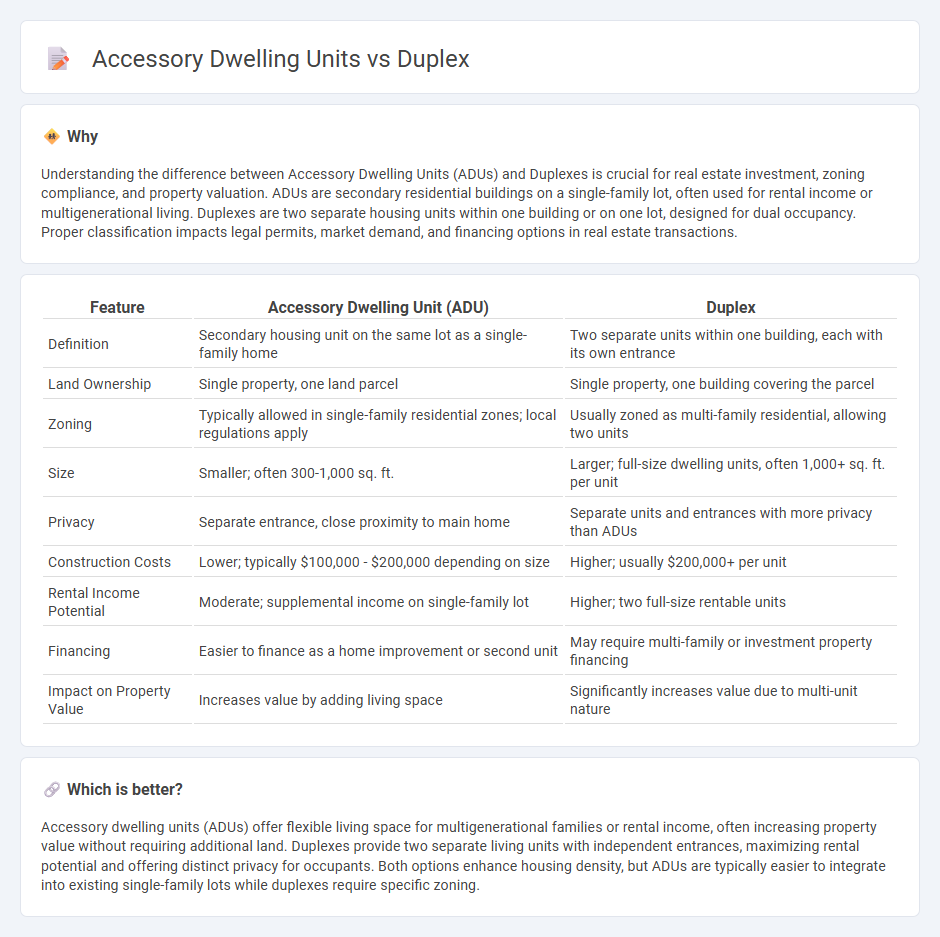
Accessory dwelling units (ADUs) provide a flexible housing option by adding a secondary living space on a single property, ideal for multigenerational families or rental income. Duplexes consist of two separate units within one building, offering distinct living spaces with shared walls, enabling multi-family living while maximizing land use. Explore the benefits and differences between ADUs and duplexes to determine the best real estate investment for your needs.
Why it is important
Understanding the difference between Accessory Dwelling Units (ADUs) and Duplexes is crucial for real estate investment, zoning compliance, and property valuation. ADUs are secondary residential buildings on a single-family lot, often used for rental income or multigenerational living. Duplexes are two separate housing units within one building or on one lot, designed for dual occupancy. Proper classification impacts legal permits, market demand, and financing options in real estate transactions.
Comparison Table
| Feature | Accessory Dwelling Unit (ADU) | Duplex |
|---|---|---|
| Definition | Secondary housing unit on the same lot as a single-family home | Two separate units within one building, each with its own entrance |
| Land Ownership | Single property, one land parcel | Single property, one building covering the parcel |
| Zoning | Typically allowed in single-family residential zones; local regulations apply | Usually zoned as multi-family residential, allowing two units |
| Size | Smaller; often 300-1,000 sq. ft. | Larger; full-size dwelling units, often 1,000+ sq. ft. per unit |
| Privacy | Separate entrance, close proximity to main home | Separate units and entrances with more privacy than ADUs |
| Construction Costs | Lower; typically $100,000 - $200,000 depending on size | Higher; usually $200,000+ per unit |
| Rental Income Potential | Moderate; supplemental income on single-family lot | Higher; two full-size rentable units |
| Financing | Easier to finance as a home improvement or second unit | May require multi-family or investment property financing |
| Impact on Property Value | Increases value by adding living space | Significantly increases value due to multi-unit nature |
Which is better?
Accessory dwelling units (ADUs) offer flexible living space for multigenerational families or rental income, often increasing property value without requiring additional land. Duplexes provide two separate living units with independent entrances, maximizing rental potential and offering distinct privacy for occupants. Both options enhance housing density, but ADUs are typically easier to integrate into existing single-family lots while duplexes require specific zoning.
Connection
Accessory dwelling units (ADUs) and duplexes both serve as valuable solutions for increasing housing density within residential zones without substantial land expansion. ADUs are secondary housing units built on a single-family lot, often offering affordable rental options, while duplexes consist of two separate living units under one roof designed for dual occupancy. Both structures enhance urban infill strategies, support diverse housing needs, and contribute to local real estate market flexibility.
Key Terms
Zoning
Duplexes and accessory dwelling units (ADUs) differ significantly in zoning regulations, with duplexes typically allowed in zones permitting multi-family dwellings, while ADUs are often permitted as secondary units on single-family lots. Zoning codes influence factors such as lot size, setbacks, and parking requirements, impacting the feasibility and design of each housing type. Explore local zoning ordinances to understand specific allowances and restrictions for duplexes and ADUs in your area.
Ownership Structure
Duplexes typically feature a single ownership with both units under one title, facilitating joint financing and shared property taxes, whereas accessory dwelling units (ADUs) often coexist on a primary residence's lot but are part of the same ownership entity. Duplex ownership can enhance rental income opportunities by allowing separate tenant leases, while ADUs offer flexible living spaces without the need for a subdivided title or complex legal arrangements. Explore further to understand how ownership structure impacts investment potential and regulatory considerations in both housing options.
Separate Utilities
Duplexes typically share a single utility connection, streamlining infrastructure but potentially limiting billing options and privacy. Accessory dwelling units (ADUs) feature separate utilities, enabling individual metering for electricity, water, and gas, which promotes tenant autonomy and accurate cost allocation. Explore the differences in utility management between duplexes and ADUs to determine the best housing solution for your needs.
Source and External Links
Duplex (2003) - A dark comedy film about a young couple moving into a duplex in New York, starring in a story full of humor and suspense.
Duplex for Rent - Long Island, NY - 50 Listings - Listings of duplex apartments available for rent in Long Island, NY, including details on pricing and features.
THE DUPLEX - A piano bar and cabaret theatre offering live performances and happy hour specials in New York City.
 dowidth.com
dowidth.com